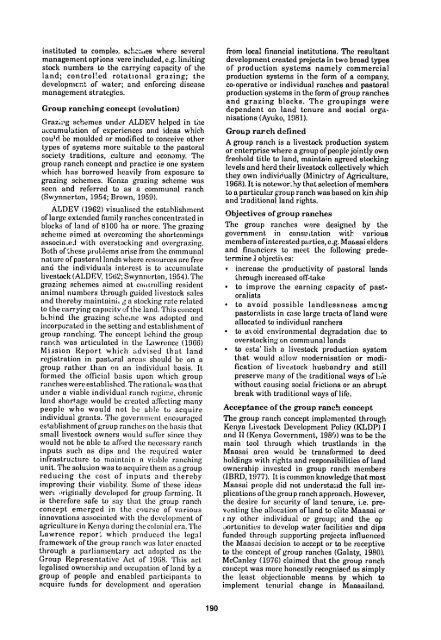aistand south~ern afrkca - (PDF, 101 mb) - USAID
aistand south~ern afrkca - (PDF, 101 mb) - USAID
aistand south~ern afrkca - (PDF, 101 mb) - USAID
You also want an ePaper? Increase the reach of your titles
YUMPU automatically turns print PDFs into web optimized ePapers that Google loves.
instituted to comple), sch;,,es where several from local financial institutions. The resultant<br />
management options Were included, e.g. limiting<br />
stock nu<strong>mb</strong>ers to the carrying capacity of the<br />
land; controlTed rotational grazing; the<br />
developmcnt of water; and enforcing disease<br />
management strategies.<br />
Group ranching concept (evolution)<br />
Graz.',g schemes under ALDEV helped in the<br />
accumulation of experiences and ideas which<br />
could be moulded or modified to conceive other<br />
types of systems more suitable to the pastoral<br />
society traditions, culture and economy. The<br />
group ranch concept and practice is one system<br />
which has borrowed heavily from exposure to<br />
grazing schemes. Konza grazing scheme was<br />
seen and referred to as a communal ranch<br />
(Swynnerton, 1954; Brown, 1959).<br />
ALDEV (1962) visualised the establishment<br />
of large extended family ranches concentrated in<br />
blocks of land of 8100 ha or more. The grazing<br />
scheme aimed at overcoming the shortcomings<br />
associaciJ with overstocking and overgrazing,<br />
Both of these problems arise from the communal<br />
nature of pastoral lands where resources are free<br />
and the individuals intrest is to accumulate<br />
livestock (ALDEV. 1962; Swynnerton, 1954). The<br />
grazing schemes aimed at coitrolling resident<br />
animal nu<strong>mb</strong>ers through guided livestock sales<br />
and thereby maintaini. g a stocking rate related<br />
to the carrying capacity ,f the land. This concept<br />
behind the grazing scheme was adopted and<br />
incorporated in the setting and establishment of<br />
group ranching. The concept behind the group<br />
ranch was articulated in the Lawrence (1966)<br />
Mission Report which advised that land<br />
registration in pastoral areas should be on a<br />
group rather than en an individual basis. It<br />
formed the official basis upon which group<br />
ranches were established. The rationale was that<br />
under a viable individual ranch regime, chronic<br />
land shortage would be created affecting many<br />
people who would not be able to acquire<br />
individual grants. The government encouraged<br />
establishment ofgroup ranches on the basis that<br />
small livestock owners would suffer since they<br />
would not be able to afford the necessary ranch<br />
inputs such as dips and the required water<br />
infrastructure to maintain a viable ranching<br />
unit. The soludon was to acquire them asa group<br />
reducing the cost of inputs and thereby<br />
improving their viability. Some of these ideas<br />
wer. originally developed for group farming. It<br />
is therefore safe to say that the group ranch<br />
concept emerged in the course of various<br />
innovations associated with the development of<br />
agriculture in Kenya during the colonial era. The<br />
Lawrence repor, which produced the legal<br />
framework of the group ranch was later enacted<br />
through a parliamentary act adopted as the<br />
Group Representative Act of 1968. This act<br />
legalised ownership and occupation of land by a<br />
group of people and enabled participants to<br />
acquire fhnds for development and operation<br />
190<br />
development created projects in two broad types<br />
of production systems namely commercial<br />
production systems in the form of a company,<br />
co-operative or individual ranches and pastoral<br />
production systems in the form of group ranches<br />
and grazing blocks. The groupings were<br />
dependent on land tenure and social organisations<br />
(Ayuko, 1981).<br />
Group rarch defined<br />
A group ranch is a livestock production system<br />
or enterprise where a group of peoplejointly own<br />
freehold title to land, maintain agreed stocking<br />
levels and herd their livestock collectively which<br />
they own individually (Minictry of Agriculture,<br />
1968). It is noteworhy that selection of me<strong>mb</strong>ers<br />
to a particular group ranch was based on kin ihip<br />
and traditional land rights.<br />
Objectives of group ranches<br />
The group ranches were designed by the<br />
government in consuitation wit various<br />
me<strong>mb</strong>ers ofinterested parties, e.g. Maasai elders<br />
and financiers to meet the following predetermine<br />
1 objectih es:<br />
* increase the productivity of pastoral lands<br />
through increased off-take<br />
• to improve the earning capacity of pastoralists<br />
* to avoid possible landlessness amcng<br />
pastoralists in case large tracts of land were<br />
allocated to individual ranchers<br />
to aoid environmental degradation due to<br />
overstocking on communal lands<br />
• to esta' lish a livestock production system<br />
that would allow modernisation or modification<br />
of livestock husbandry and still<br />
preserve many of the traditional ways of l!e<br />
without causing social frictions or an abrupt<br />
break with traditional ways of life.<br />
Acceptance of the group ranch concept<br />
The group ranch concept implemented through<br />
Kenya Livestock Development Policy (KLDP) I<br />
and II (Kenya Government, 1980) was to be the<br />
main tool through which trustlands in the<br />
Maasai area would be transformed to deed<br />
holdings with rights and responsibilities of land<br />
ownership invested in group ranch me<strong>mb</strong>ers<br />
(IBRD, 1977). It is common knowledge that most<br />
Maasai people did not understand the full irnplications<br />
ofthe group ranch approach. However,<br />
the desire for security of land tenure, i.e. provnting<br />
the allocation of land to elite Maasai or<br />
i ny other individual or group; and the op<br />
jortunities to develop water facilities and dips<br />
funded through supporting projects influenced<br />
the Maasai decision to accept or to be receptive<br />
to the concept of group ranches (Galaty, 1980).<br />
McCanley (1976) claimed that the group ranch<br />
concept was more honestly recognised as simply<br />
the least objectionable means by which to<br />
implement tenurial change in Maasailand.

















